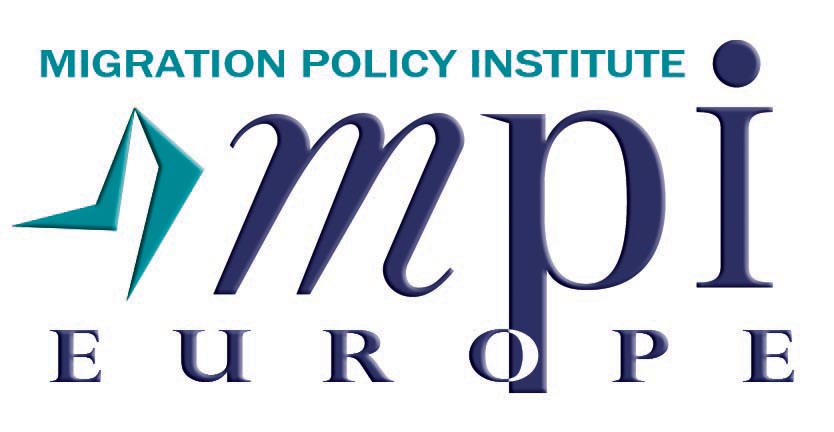


Below is a sample of the emails you can expect to receive when signed up to Migration Information.
|
To ensure email delivery directly to your inbox, please add
|
|
To ensure email delivery directly to your inbox, please add
|
 |
To ensure email delivery directly to your inbox, please add source@migrationpolicy.org to your address book and migrationpolicy.org to your safe senders list.
|
|||||||||||||
 |
||||||||||||||
Also in the Newsletter Have You Read? The Limited English Proficient Population in the United States The Multicultural Dilemma: Amid Rising Diversity and Unsettled Equity Issues, New Zealand Seeks to Address Its Past and Present As Lesvos Battles Migration Crisis Fatigue, the Value of Centralized Migration Decision-Making Is Questioned Keep up with the Source  Subscribe SubscribeNot on the list? Continue receiving these updates by subscribing today.
RSS Feed Follow MPI
One Year after the U.S.-Mexico Agreement: Reshaping Mexico’s Migration Policies By Ariel G. Ruiz Soto Un año después del Acuerdo Estados Unidos-México: La transformación de las políticas migratorias mexicanas By Ariel G. Ruiz Soto Using Evidence to Improve Refugee Resettlement: A Monitoring and Evaluation Road Map By Aliyyah Ahad, Camille Le Coz, and Hanne Beirens COVID-19 Spotlights the Inequities Facing English Learner Students, as Nonprofit Organizations Seek to Mitigate Challenges By Melissa Lazarín USCIS Budget Implosion Owes to Far More than the Pandemic By Sarah Pierce and Doris Meissner |
Reports that Greece has placed some asylum seekers into tented inflatable rafts without motors or paddles and towed them towards Turkish territorial waters offer the latest evidence of the difficult conditions facing those seeking to reach Europe’s shores, as well as ongoing brinksmanship between Greece and Turkey over migration. Encounters with such rafts were logged 11 times by the Turkish Coast Guard and nongovernmental organizations between March 23 and May 22, raising questions whether these actions violate international protection and human-rights standards. Greece has been accused of illegal pushbacks before, with reports that some arriving asylum seekers are being stripped of their documents and personal belongings and then forced back into Turkey. The Greek Ministry of Migration and Asylum denies the reports. An agreement the European Union and Turkey struck in 2016, amid a massive surge in arrivals of Syrians and others, was meant to deter migrants from setting off from coastal Turkey in route to the Greek islands and hoped-for movement deeper into Europe. Complaining that European leaders had failed to live up to their end of the bargain, Turkish President Recep Tayyip Erdoğan upended the deal in February, encouraging tens of thousands of migrants in Turkey to head towards the Greek land border, where they were met with tear gas, water cannons, and stun grenades. On March 1, Greek Prime Minister Kyriakos Mitsotakis announced his country would temporarily refuse to accept asylum applications—a move at odds with European and international law. “The borders of Greece are the external borders of Europe. We will protect them,” Mitsotakis tweeted. The suspension of the asylum procedure ended on April 1 but was renewed through May 18 because of the COVID-19 pandemic. When the system reopened, the Greek government began processing new applications and granted a six-month extension to refugees holding current residence permits. Tensions between the Greek and Turkish governments continue, with guards at the shared border at the Evros river on high alert recently over reports of a possible new surge of irregular migrants. The Greek government is responding with construction of new fencing at the river and the deployment of more law enforcement and resources. Greek officials are closely watching to see if Turkey permits new onward movement by migrants, though reports suggest no organized plan at present. Though the coronavirus lockdown pushed the dispute aside for a brief while, tensions appear to be reheating—and asylum seekers and migrants immobilized by the pandemic may soon be on the move again. Best regards, Editor, Migration Information Source source@migrationpolicy.org
|
|||||||||||||
|
To ensure email delivery directly to your inbox, please add
|
 |
To ensure email delivery directly to your inbox, please add source@migrationpolicy.org to your address book and migrationpolicy.org to your safe senders list.
|
|||||||||||||||
 |
||||||||||||||||
Have You Read?
International Students in the United States
RSS Feed Follow MPI
Greece’s Moria Tragedy: The Crash Test for the EU Pact on Migration and Asylum Venezuelan Migration, Crime, and Misperceptions: A Review of Data from Colombia, Peru, and Chile Inmigrantes venezolanos, crimen y percepciones falsas: Un análisis de los datos en Colombia, Perú y Chile
The Migration Policy Institute seeks exceptional candidates for a new position. Learn more and please share with your networks!
Program Assistant, National Center on Immigrant Integration Policy
Unforgetting: A Memoir of Family, Migration, Gangs, and Revolution in the Americas features writer Roberto Lovato exploring his family’s experience as part of a broader story of migration and violence in El Salvador and the United States. Former Iranian refugee Dina Nayeri meditates on her own story and those of other asylees in The Ungrateful Refugee: What Immigrants Never Tell You.
The Last Million: Europe''s Displaced Persons from World War to Cold War by David Nasaw tells the story of the roughly 1 million displaced people left in Germany at the end of World War II.
In One Billion Americans: The Case for Thinking Bigger, journalist Matthew Yglesias argues for dramatically increasing the U.S. population.
Anne Marie Baylouny examines political dynamics in refugee-receiving countries in When Blame Backfires: Syrian Refugees and Citizen Grievances in Jordan and Lebanon.
Targeted to teens and young adults, In Search of Safety: Voices of Refugees tells the story of five refugees in the United States.
The Guardian''s Today in Focus podcast recently explored unauthorized immigrants it has labeled “Europe’s dreamers."
|
What happens when refugees and other migrants are caught up in disasters that destabilize their new homes? Sadly, there have been no shortage of opportunities to find out. Worldwide, the COVID-19 pandemic has had a disproportionate impact on migrant workers, including in places such as the United States and the Persian Gulf, and the virus has spread quickly in confined camps for refugees and asylum seekers. Additional disasters have been heaped on top of this public-health crisis. Most notably, fires devastated the Moria refugee camp on the Greek island of Lesvos last week, displacing thousands of people in the overcrowded camp. The consequences of this fire will reverberate through multiple levels: for local dynamics between residents and new arrivals in Lesvos, for Greece''s relationship with migrants, and for Europe''s attitude towards the Eastern Mediterranean and external borders more broadly. Hanne Beirens, the Director of MPI Europe, has outlined some of the steps necessary to develop a path forward in an excellent new commentary. Refugees and other migrants often bear the brunt of a range of disasters worldwide. For instance, a sizeable portion of the 200 casualties from the August 4 explosion that devastated Beirut were migrants from Syria and elsewhere, and many of Lebanon''s 1.5 million refugees—the largest per capita population worldwide—may suffer economic consequences of the fallout. As new arrivals, migrants often lack the social safety nets to fall back on when jobs, homes, and communities are wiped away. They may not know the local language, have the skills to navigate opportunities for aid, or be able to access government benefit systems. This vulnerability makes them prime targets for abuse and exploitation. Some unauthorized migrant farmworkers in California were encouraged to ignore evacuation orders ahead of recent wildfires that have ravaged the state, and others have been unpaid or underpaid for work such as hurricane cleanup. After 2011 flooding in Thailand, migrants paid high fees to illicit brokers who would take them on dangerous trips to the Myanmar border. Still, there have been reports of remarkable recovery, strength, and resilience in the face of crisis. Refugees raced to help in the aftermath of the Beirut blast, and migrants rallying together are a feature of disasters from storms in Iowa to flooding in Thailand. Paradoxically, migrants can be both especially vulnerable and especially resilient in the face of crisis. "Their resilience arises partly from the everyday inequalities that they already confront, and partly because of previous experiences of disasters," scholars Shinya Uekusa and Steve Matthewman wrote in a 2017 analysis. Maegan Hendow examined some of these issues in a 2018 article in the Migration Information Source that remains tragically relevant. Migrants caught in crisis can find themselves in a protection gap, she wrote, unable to fully access assistance from governments, aid groups, or international organizations. While it is impossible to tell when the next disaster will strike, it is a safe bet that migrant populations may be exposed to some of its hardest impacts.
Best regards,
|
|||||||||||||||
 |
To ensure email delivery directly to your inbox, please add source@migrationpolicy.org to your address book and migrationpolicy.org to your safe senders list.
|
|||||||||||||||
 |
||||||||||||||||
Have You Read?
The New Reality: Germany Adapts to Its Role as a Major Migrant Magnet
RSS Feed Follow MPI
Immigration Enforcement and the Mental Health of Latino High School Students Venezuelan Migrants and Refugees in Latin America and the Caribbean: A Regional Profile Un perfil regional de los migrantes y refugiados venezolanos en América Latina y el Caribe
The Migration Policy Institute seeks exceptional candidates for two new positions. Learn more and please share with your networks!
Policy Analyst/Associate Policy Analyst, Human Services Initiative
The migration policy world gets a new glossary with the bilingual A is for Asylum Seeker: Words for People on the Move, by Rachel Ida Buff. Michael Kagan''s The Battle to Stay in America: Immigration''s Hidden Front Line focuses on Las Vegas as a microcosm for the U.S. immigration legal system.
Author Steven Dudley tells the complicated story of an oft-sensationalized criminal organization formed by migrants in MS-13: The Making of America''s Most Notorious Gang.
The National Immigration Forum has begun a new series of its Only in America podcast, focusing on racial justice an immigration. A previous series, asking “How did we get here?” features an interview with MPI’s Doris Meissner.
A Better Life? is a new podcast from Feet in 2 Worlds documenting how COVID-19 is affecting immigrants in the United States.
|
It was a bold call that reverberated around the world five years ago this week. “Wir schaffen das,” claimed German Chancellor Angela Merkel, shortly after visiting a refugee center near Dresden. “We can do it.”
The number of asylum seekers and other migrants coming to Germany was beginning to ascend, and Merkel would soon open the doors to as many as 1.2 million of them, many from Syria, over 2015 and 2016. As a political matter, the phrase began to haunt Merkel. Critics including the far-right Alternative for Germany threw it back in her face. They blamed the welcoming policy for encouraging large numbers of arrivals and tied it to violence and criminal acts blamed on recently arrived migrants and asylees, including sexual assaults on New Year’s Eve in Cologne and other cities, and, in 2016, a suicide bombing at a music festival in Ansbach carried out by a failed asylum seeker.
Five years later, did Germany “do it?”
Merkel seems to think so. She “would make essentially the same decisions” if she were asked to repeat the period again, she said at a press conference last week. More and more migrants have found work in Germany; still, only half of those who have arrived since 2013 have full-time paying jobs, according to a study released earlier this year. Among German residents, 51 percent rejected Merkel’s asylum policy in a new survey, compared to less than one-third who supported it. Tellingly, the proportion of respondents who once supported the policy but have changed their mind was more than three times as large as those who once rejected it but now support.
The story has been different—but no less complicated—elsewhere in the world. Last week marked three years since Myanmar’s security forces launched a violent crackdown on the Rohingya people in the country’s western Rakhine state, sending more than 650,000 into neighboring Bangladesh. Many moved into crowded camps and informal settlements in Bangladesh’s southern Cox’s Bazar district, where other Rohingya had been living for years. Combined with earlier-arrived migrants, there are now approximately 1 million Rohingya in the country.
Bangladesh has had no interest in taking a cue from Germany. The Rohingya are “a threat to security,” Prime Minister Sheikh Hasina said last year. She has pushed to have them repatriate, despite earlier failed attempts and efforts by Myanmar to make return more difficult. The government has limited assistance available to migrants and conditions in the camps have deteriorated.
There are obvious and major differences between the two countries. Despite being led by women who have been in office for at least a decade, Germany and Bangladesh took sharply different approaches when confronted with major upticks in arrivals of people fleeing conflict. Managing these arrivals looks different in different settings, but these two cases offer a display in miniature of the differing paths that countries have taken. Whether or not they can “do it” depends on what they intend to do.
Best regards,
|
|||||||||||||||
|
To ensure email delivery directly to your inbox, please add
|
|
To ensure email delivery directly to your inbox, please add
|
|
||||
|
The Evolution of U.S. Homeland Security in the 21st Century
|
||||
|
||||
|
Created in the wake of the 9/11 terrorist attacks in the largest reorganization of the federal government since World War II, the Department of Homeland Security (DHS) was designed to coordinate and execute a comprehensive national strategy to safeguard the country against terrorism. DHS was also tasked with carrying out all functions of the 22 federal agencies and entities that were entirely or partially folded into the new department, ensuring that those not directly related to protection of the homeland were not diminished nor neglected. With a portfolio covering everything from cybersecurity and protection of the nation’s maritime waters to facilitation of trade and emergency management, DHS is arguably the largest federal agency with the most disparate policy goals.
What does it mean to “secure the homeland” in the 21st century? What lessons can be drawn from the U.S. government efforts to do so? And how do DHS work and operations on migration and border security figure into the equation?
With the department well into its second decade and on the precipice of a new presidential term with some of its component agencies pulled into the polarization around immigration and border security, join the Migration Policy Institute (MPI) for a discussion with the editors and authors of Beyond 9/11: Homeland Security for the Twenty-First Century. These leading security experts will assess the department’s evolution and how it organizes its operations and work on migration and border management. They will offer crucial strategic lessons and detailed recommendations on how to improve the U.S. homeland security enterprise.
|
||||
|
 |  | |
Unsubscribe from any further emails from us. | ||
 |
To ensure email delivery directly to your inbox, please add source@migrationpolicy.org to your address book and migrationpolicy.org to your safe senders list.
|
||||||||||||||
 |
|||||||||||||||
Have You Read?
Ally or Exploiter? The Smuggler-Migrant Relationship Is a Complex One
RSS Feed Follow MPI
Will International Migration Governance Survive the COVID-19 Pandemic? Immigrant-Origin Students in U.S. Higher Education: A Data Profile Broad and Blunt, the Trump Administration’s H-1B Changes Miss the Opportunity for Real Reform Supporting Immigrant and Refugee Families through Home Visiting: Innovative State and Local Approaches The EU Pact on Migration and Asylum—A Bold Move to Avoid the Abyss?
The latest episode of MPI’s Moving Beyond Pandemic podcast examines the future of travel at airports. A new book from researcher Justin Schon, Surviving the War in Syria: Survival Strategies in a Time of Conflict, analyzes migration and other responses to violence. Out this month from academics James A. McCann and Michael Jones-Correa, Holding Fast: Resilience and Civic Engagement Among Latino Immigrants evaluates how U.S. policy changes have affected political attitudes and civic participation among Latino immigrants.
NPR correspondent Aarti Namdev Shahani’s Here We Are: To Migrate to America… It’s the Boldest Act of One’s Life is a memoir about her immigrant family in the United States.
From South Africa, Should We Go?: To Emigrate or Not: 21 Voices Speak Their Mind, compiled by Alet Law, features reflections on emigration.
Former Arizona politician Bob Worsley examines his country’s changing politics in The Horseshoe Virus: How the Anti-Immigration Movement Spread from Left-Wing to Right-Wing America.
Historian Claire Zalc’s award-winning Denaturalized: How Thousands Lost Their Citizenship and Lives in Vichy France is now available in English.
|
Two years ago this week, about 160 people set off from San Pedro Sula, Honduras, headed towards Mexico and, for many, eventually the United States. In following weeks their numbers would swell to form a caravan of about 7,000 people that moved into Guatemala and across the Mexican border, traveling in a group for safety and as a political signal. In the United States, the migrants became a rallying cry for President Donald Trump ahead of midterm elections that would see his Republican Party expand its Senate majority. In recent weeks, another migrant caravan left from Honduras heading north, but this one did not get very far. More than 3,700 Hondurans were turned back in Guatemala, where hundreds of police and military officials set up roadblocks and where, previously U.S. border agents may controversially have been involved in on-the-ground operations. Mexico had similarly deployed a heavy presence along its southern border to block passage. The episode underscores changing migration dynamics in the Americas and around the world. For one, it is testament to how the COVID-19 pandemic is fundamentally altering human movement. Guatemalan and Mexican government leaders cited the health crisis as the reason they halted the migrants’ path, although human-rights groups claimed the pandemic was being used as a pretext. Meanwhile, some migrants said that the poverty, violence, and corruption that prompted their flight had only gotten worse during the outbreak. The caravan’s fate was also a sign of the changing posture by the Guatemalan and Mexican governments, which appear to have coordinated their response. Guatemala had previously done little to stop migrants’ passage, but this time President Alejandro Giammattei declared the travelers could “put us at serious risk” and suspended some constitutional rights to detain them. Mexico, meanwhile, has increasingly taken a tougher posture towards Central American migrants, partly in response to threatened U.S. tariffs. Finally, the caravan highlighted how immigration has, oddly, faded from the limelight of U.S. politics. Trump built his 2016 campaign around restricting immigration, has taken more than 400 immigration-related executive actions, and can exploit a deep partisan divide on the issue. But with less than a month until the election, the president was oddly quiet about the new caravan. In fact, the politician who connected it to U.S. politics was Mexican President Andrés Manuel López Obrador. Migration developments can be fluid, as the recent caravan demonstrated. The flows evolve in response to policy, politics, and broader circumstances, all of which are constantly changing.
Best regards,
|
||||||||||||||
 |
To ensure email delivery directly to your inbox, please add source@migrationpolicy.org to your address book and migrationpolicy.org to your safe senders list.
|
|||||||||||||
 |
||||||||||||||
Vulnerable to COVID-19 and in Frontline Jobs, Immigrants Are Mostly Shut Out of U.S. Relief
RSS Feed Follow MPI
The Migration Policy Institute seeks exceptional candidates for two new positions. Learn more and please share with your networks!
|
After the most sweeping restrictions on movement in decades, the world—or at least part of it—is beginning to imagine the end of border closures. Limitations on mobility stemming from the COVID-19 pandemic remain widespread, both internationally and, in countries such as Australia, internally. Economies have spiraled, migrants have been left stranded, and access to asylum has shrunk. In recent weeks, the European Union has begun experimenting with what it might look like for countries to reopen, first by encouraging Member States to recommit to free movement and providing guidance allowing residents of 15 non-EU countries access to the bloc. By early indications, the transition is neither smooth nor uniform. Major powers such as the United States, Russia, and Brazil are excluded, and China’s addition is contingent on Beijing granting reciprocal access for EU travelers. Hungary, which lifted many of its border controls in May, reversed course this week and will now bar foreigners from certain high-risk countries and require quarantines for those from countries with a “yellow” risk warning. Europeans from areas with high rates of COVID-19, including Sweden and Portugal, will face quarantines at some borders, including those of Belgium and Estonia. The EU guidelines include exemptions for long-term residents, asylum seekers, and people “with an essential function or need,” including seasonal agricultural workers and medical professionals. Border restrictions have been rolled back in a few other countries, many of which are small island states or places dependent on tourism. But by and large, the European Union’s stutter-steps toward reopening remain the exception, with much of the world maintaining partial or total restrictions on movement. On July 9, the International Organization for Migration reported 220 countries, territories, or areas had issued travel restrictions. Given the tenacity of the coronavirus, full return to pre-pandemic mobility seems far off. In the meantime, one strategy gaining popularity is the adoption of “travel bubbles” for small groups of countries, allowing citizens and residents to travel within the zone while limiting access to foreigners. Lithuania, Latvia, and Estonia created the first such European bubble in May. A trans-Tasman bubble had been proposed for Australia, New Zealand, and some countries in the Asia-Pacific, but was put on hold amid renewed outbreaks. Bilateral travel agreements are also on the rise. The United Kingdom has set up “travel corridors” to dozens of countries—including tropical locales popular with summer travelers—without mandates for quarantine. Since April, China has sought bilateral “fast-track” agreements with countries including South Korea and Singapore, although the scheme have been limited to sponsored travelers who are subjected to COVID-19 testing and other measures. Even when broader mobility resumes, it could become the norm for border officials to require testing and contact tracing. As MPI’s Meghan Benton wrote in May, the coming months will force countries to make tough decisions that could have far-reaching consequences. A long journey awaits, but Europe’s new experiment amounts to a tentative first step.
Best regards, Julian Hattem Editor, Migration Information Source source@migrationpolicy.org
|
|||||||||||||
|
To ensure email delivery directly to your inbox, please add
|
|
To ensure email delivery directly to your inbox, please add
|
|
To ensure email delivery directly to your inbox, please add
|
|
To ensure email delivery directly to your inbox, please add
|
 |
To ensure email delivery directly to your inbox, please add source@migrationpolicy.org to your address book and migrationpolicy.org to your safe senders list.
|
|||||||||||||
 |
||||||||||||||
Also in the Newsletter Have You Read? To Stay or Not To Stay: The Calculus for International STEM Students in the United States Life After Trauma: The Mental-Health Needs of Asylum Seekers in Europe Welcome Wears Thin for Colombians in Ecuador as Venezuelans Become More Visible Keep up with the Source  Subscribe SubscribeNot on the list? Continue receiving these updates by subscribing today.
RSS Feed Follow MPI
Infographic: Mixed-Status Families Ineligible for CARES Act Federal Pandemic Stimulus Checks |
Throughout civilization, life on Earth has thrived in an environmental niche characterized by median temperatures between 11 and 15 degrees Celsius (52 to 59 degrees Fahrenheit), a key factor in the production of crops and livestock that sustain human life. However, a new National Academy of Sciences study reveals that if the planet continues to warm at current rates, up to 3 billion people will be living in regions inhospitable to human life by 2070. Based on study estimates, in just 50 years 19 percent of the planet could experience an average temperature of 29 degrees Celsius (84 degrees Fahrenheit), similar to that of the Sahara Desert. Looking at the current population distribution, this would include more than 1 billion people in India, 500 million in Nigeria, and 100 million in the Niger and Sudan region. Ultimately, for every 1 degree Celsius of global average warming, 1 billion people will have to either adapt or migrate. While these predictions are based on future temperature estimates, the increased frequency of climate-linked natural disasters is already causing large-scale migration, especially in South Asia. In 2019, natural disasters triggered the internal displacement of 24.9 million people around the world, three times the number caused by conflict and violence. India, Bangladesh, and the Philippines had the highest numbers, each experiencing more than 4 million climate-related displacements. In this region, monsoon rains and tropical storms have become more frequent and more intense, causing unprecedented levels of flooding and damage. Furthermore, with sea levels rising, the resulting salinization of coastal land harms crop production for multiple seasons, devastating the livelihoods of farmers. India is considered by many scientists to be the country at highest risk, with 250 million people living along the coastline—most dependent on the sea for their livelihood. While climate migration is currently categorized by mostly internal displacement and disproportionately affects developing nations, it will increasingly touch all parts of the globe as temperatures increase and weather patterns get more severe. According to Climate Central, by 2050, seas could rise to levels that at high tide would erase global cities such as Miami, Amsterdam, Bangkok, Shanghai, and Mumbai. Furthermore, drought-fueled wildfires similar to those that raged in California and Australia recently are set to become more frequent. While the outlook appears grim, there is still time to prevent some of the worst-case scenarios. In order to do so, it will take unprecedented contingency planning by governments and international institutions. The COVID-19 pandemic has highlighted how systems can be pushed to near collapse when governments are not prepared for crisis. Will the world learn from this pandemic? The coming decade will tell. Interested in learning more about climate migration? We are excited to announce we will be launching our Climate Migration Special Issue later this month. So please stay tuned! Best regards, Editor, Migration Information Source source@migrationpolicy.org
|
|||||||||||||
|
To ensure email delivery directly to your inbox, please add
|
|
To ensure email delivery directly to your inbox, please add
|
|
To ensure email delivery directly to your inbox, please add
|
|
To ensure email delivery directly to your inbox, please add
|
|
To ensure email delivery directly to your inbox, please add
|
|
To ensure email delivery directly to your inbox, please add
|
|
To ensure email delivery directly to your inbox, please add
|
 |
To ensure email delivery directly to your inbox, please add source@migrationpolicy.org to your address book and migrationpolicy.org to your safe senders list.
|
|||||||||||||
 |
||||||||||||||
Also in the Newsletter Have You Read? Global Demand for Medical Professionals Drives Indians Abroad Despite Acute Domestic Health-Care Worker Shortages “Us” or “Them”? How Policies, Public Opinion, and Political Rhetoric Affect Immigrants’ Sense of Belonging Profiting from Enforcement: The Role of Private Prisons in U.S. Immigration Detention Keep up with the Source  Subscribe SubscribeNot on the list? Continue receiving these updates by subscribing today.
RSS Feed Follow MPI
INFOGRAPHIC: The Essential Role of Immigrants in the U.S. Food Supply Chain
ALL MPI CORONAVIRUS RESOURCES
|
As K-12 schools around the United States transition to distance learning amid the COVID-19 pandemic, there is concern that English Learners (ELs) could be left behind. According to the most recent U.S. Department of Education data, there are more than 4.8 million EL students, representing 10 percent of public school enrollment. Due to more limited technology access, language barriers, and often stressful home situations, these students face unique challenges in keeping their education on track. A December U.S. Department of Education report revealed that many EL students do not have access to the technology resources necessary for virtual learning, with many immigrant families lacking at-home Internet connectivity and having to rely on limited cell phone data plans or no Internet access at all. As a result, with schools transitioning lessons and assignments online, many ELs are disconnected from their teachers and course plans. They also face new language hurdles, as many ELs depend on in-class bilingual support staff to help them complete assignments and contribute to class conversation. As education has shifted from the classroom to the home, this role is one that has shifted to parents and guardians. But while districts are providing resources to help parents assume a greater role in their children’s education, these aids are often only in English, making things difficult for the parents, who often have lower levels of English fluency than their children. Students in immigrant families may also be experiencing added stress in the home that can be distracting to their education, as immigrant communities have been among those hard hit by the shutdown of nonessential businesses. The stressors may be even greater for those families with an unauthorized immigrant member, which are cut off from federal pandemic relief. Without a valid Social Security number, unauthorized immigrants are not eligible to receive the $1,200 federal stimulus check (even if they have a valid taxpayer identification number) and are unable to apply for unemployment, leaving families, many without savings, with no source of income. Food security has also become an issue for many children who typically rely on school meals. Even as the pandemic and resulting economic fallout have emphasized deep inequalities in society, many school districts and teachers have stepped up to try and fill in the gaps for their EL students. Districts across the country, including in New York City and Washington, D.C., have been providing low-income students with laptops, iPads, and WiFi hotspots. Recognizing the difficulty ELs may have in navigating different learning platforms and multiple instructional emails, a teacher in Kentucky has created daily organized assignment spreadsheets for her EL students, walking them through each assignment over the phone in Spanish. Finally, many students in immigrant families live in crowded homes with multiple generations, spurring educators to increase their outreach to ELs on how to prevent the spread of COVID-19 , keeping students and their families safe during this uncertain time. Best regards, Editor, Migration Information Source source@migrationpolicy.org
|
|||||||||||||
|
To ensure email delivery directly to your inbox, please add
|
 |
To ensure email delivery directly to your inbox, please add source@migrationpolicy.org to your address book and migrationpolicy.org to your safe senders list.
|
||||||||||||||
 |
|||||||||||||||
Have You Read?
The U.S. Presidential Campaign Cements Political Parties’ Deepening Schism on Immigration
RSS Feed Follow MPI
Rethinking the U.S.-Mexico Border Immigration Enforcement System: A Policy Road Map Navigating the Future of Work: The Role of Immigrant-Origin Workers in the Changing U.S. Economy
The latest episode of MPI’s Moving Beyond Pandemic podcast looks at how COVID-19 has impacted mobility around the world. Haven: The Mediterranean Crisis and Human Security, edited by John Morrissey, offers a new perspective on asylum seekers crossing the Mediterranean. Cruelty as Citizenship: How Migrant Suffering Sustains White Democracy, by Cristina Beltrán, looks at the role Mexican and Latin American immigrants play in U.S. political rhetoric.
Grace Aneiza Ali’s Liminal Spaces: Migration and Women of the Guyanese Diaspora, traces the migration narratives of 15 women from the 1950s to today.
The story of a woman caught up in a political firestorm is told in Magda Montiel Davis’s Davis’s Kissing Fidel: A Memoir of Cuban American Terrorism in the United States.
Prominent writers from Mexico weigh in on U.S. immigration policy in Let’s Talk About Your Wall: Mexican Writers Respond to the Immigration Crisis, edited by Carmen Boullosa and Alberto Quintero.
Queer and Trans Migrations: Dynamics of Illegalization, Detention, and Deportation, edited by Eithne Luibhéid and Karma R. Chávez, highlights the situation of LGBTQ migrants and communities.
|
How do voters think about immigration? It is an important question, and one that seems particularly apt ahead of next week’s U.S. national elections. Donald Trump, of course, built his successful 2016 campaign in large part around the promise to remake the U.S. immigration system to be more restrictive. Political science research suggests this focus was crucial in his ability to attract certain kinds of voters. A study published in Public Opinion Quarterly found that among White voters who did not vote Republican in 2012 but switched to Trump in 2016, attitudes on race and immigration were more important than economic factors. This cut against conventional explanations that native-born voters’ concerns about immigration are related to fears about competition for jobs. Other research has found that Trump was propelled by these voters’ concerns about losing their status as a dominant group and anxieties about residing in areas with growing numbers of Latino residents. All the more intriguing, then, that the issue has been all but absent from the current election. In 2016, immigration was the fourth most mentioned issue in the Trump campaign’s television ads, according to The Wall Street Journal. This year, it barely cracked the top ten. Meanwhile Biden, who is ahead in virtually all national polls and leading in several swing states, has hardly raised the issue at all. The explanation may come down to the notion of salience, which describes why voters believe some issues to be more important than others. While anxieties about race, immigration, and demographic change have been a longstanding undercurrent of U.S. politics, they were brought to the fore in 2016 much more than in 2020. It seems reasonable to assume that the COVID-19 pandemic and the sharp economic and labor market dislocations it caused have been more pressing concerns for many people. Significant research from Europe demonstrates the difference between an individual voter’s opinion on a given policy and the importance he or she attaches to that issue in relation to others. Research from the Netherlands, Denmark, and Germany found that voting behavior differed in response to changes in immigration policy that increase “salience and visibility of the issue.” Prominent media coverage also plays a part in this process, by highlighting particular “focus events” and raising the profile of particular individuals. Most scholarship on how immigration affects political attitudes has focused on North America and Western Europe, but there has been some research elsewhere, including in newer democracies. In the Dominican Republic, voters in areas with higher concentrations of Haitian immigrants were driven by notions of political and cultural identity and competition to disproportionately support right-wing, anti-immigration politicians. Analysis of data from 11 sub-Saharan African countries, meanwhile, found that opposition to immigration was higher around the time of the election and in countries that were more democratic and had dominant party systems. Voters’ reactions to immigration, then, are malleable. They can be shaped by a range of factors, including their own perceptions of demographic change and how politicians seize on those perceptions. In other words, public attitudes towards immigration may not always drive elections. But under the right circumstances, the issue can be decisive.
Best regards,
|
||||||||||||||
 |
To ensure email delivery directly to your inbox, please add source@migrationpolicy.org to your address book and migrationpolicy.org to your safe senders list.
|
|||||||||||||
 |
||||||||||||||
Also in the Newsletter Have You Read? International Students in the United States Maid in Hong Kong: Protecting Foreign Domestic Workers Protection and Reintegration: Mexico Reforms Migration Agenda in an Increasingly Complex Era Keep up with the Source  Subscribe SubscribeNot on the list? Continue receiving these updates by subscribing today.
RSS Feed Follow MPI
DATA TOOL: Tracing Changing U.S. Unemployment Pre-Pandemic & Now by Industry & Demographic Group
|
After weeks of being stranded at sea under life-threatening conditions, more than 300 Rohingya refugees were relocated in May by the Bangladeshi government to a remote, flood-prone island in the Bay of Bengal, despite protests from humanitarian organizations. The group earlier had been turned away from docking by authorities in Malaysia, which is the hoped-for destination for countless Rohingya living in difficult conditions in refugee camps in Bangladesh or facing persecution in Myanmar. With a total surface area of 15 square miles, the previously uninhabited island of Bhasan Char was formed just 20 years ago as a result of shifting tides and silt deposits in the Bay of Bengal. While formally a part of Bangladesh, the island is 30 kilometers from the mainland and takes three hours to travel there by boat. Prone to cyclones and heavy monsoons, about 60 percent of the island is often submerged during the rainy season. After visiting the island in January 2019, the United Nations special rapporteur on Myanmar expressed doubts over whether Bhasan Char was “truly habitable” and has since not confirmed whether the island has the shelter and aid resources necessary to sustain a refugee population. Just days after the Rohingyas’ arrival, they were moved to storm shelters on the island as Cyclone Amphan was poised to batter Indian and Bangladeshi coastal areas. While the Bangladesh government cited coronavirus concerns as the reason for sending the Rohingya to the island, plans have been in the works since 2017 to relocate up to 100,000 refugees from mainland refugee camps to Bhasan Char. The Cox’s Bazar refugee camp in southern Bangladesh is the largest such camp in the world, hosting more than 1 million Rohingya. The majority fled Myanmar in 2017 after enduring brutal military-led violence, categorized by the UN as genocide. Extreme overcrowding (at about 40,000 people per square kilometer), drug trafficking, and increasing levels of violence in the camps are among the reasons that Bangladeshi government officials began preparing Bhasan Char for habitation several years ago. After $280 million dollars in infrastructure, built by a Chinese construction company, Bhasan Char now features housing structures for more than 90,000 people, 120 cyclone shelters, warehouses to store food and other supplies, and a 13-kilometer flood-defense embankment. Amid concerns over the lack of health care, the risk of natural disasters, and further distance from Myanmar, most refugees in Cox’s Bazaar are “staunchly opposed” to relocation. However, Bhashan Char at present appears to be the only lifeline for Rohingya stranded at sea in appalling conditions, with reports of overcrowding and bodies thrown overboard. The UN High Commissioner for Refugees is urging Australia and Indonesia, which are co-chairs of the Bali Process anti-human-trafficking forum, to activate discussions between member states over a possible solution. Australia is cool to the idea, arguing the Bali Process is not the vehicle for triggering operational responses to a refugee crisis. With other boats crowded with Rohingya setting off before this most recent small flotilla, it’s sure others will take to the waters again, with or without a policy solution. Best regards, Editor, Migration Information Source source@migrationpolicy.org
|
|||||||||||||
 |
To ensure email delivery directly to your inbox, please add source@migrationpolicy.org to your address book and migrationpolicy.org to your safe senders list.
|
||||||||||||||
 |
|||||||||||||||
Have You Read?
Refugees and Asylees in the United States
RSS Feed Follow MPI
Driving Migrant Inclusion through Social Innovation: Lessons for Cities in a Pandemic Educating English Learners during the COVID-19 Pandemic: Policy Ideas for States and School Districts Brexit on the Backburner: Citizens’ Rights and the Implementation of the Withdrawal Agreement in a Pandemic
Meghan Benton, the director of research for MPI’s international program and MPI Europe, has just launched a new podcast on global mobility amid COVID-19, called Moving Beyond Pandemic. In The Great Demographic Illusion: Majority, Minority, and the Expanding American Mainstream, sociologist Richard Alba explores U.S. demographic changes. Aimed at scholars, Human Rights and The Revision of Refugee Law by Romit Bhandari examines the relationship between international refugee law and international human rights law.
Strangers to Neighbours: Refugee Sponsorship in Context, edited by Shauna Labman and Geoffrey Cameron, explores Canada’s policy allowing private individuals and groups to sponsor refugees.
Different stories of refugees resettled in Minnesota come together in Somewhere in the Unknown World: A Collective Refugee Memoir, by Kao Kalia Yang.
The Pulitzer Prize-winning graphic story of a Syrian refugee family in the United States, first published in The New York Times, has been adapted into a full-length book by Jake Halpern and Michael Sloan titled Welcome to the New World.
Acclaimed novelist and playwright Ayad Akhtar’s new work of literature, Homeland Elegies, tells of an immigrant family’s experience from the United States to Central Europe to Afghanistan.
Out October 1, Raising Global Teens by Anisha Abraham offers advice for guiding teenagers who are immigrants, dealing with cultural transitions, or otherwise navigating an unfamiliar global world.
|
The world is growing less accepting of migrants. That is the message from the latest Gallup Migration Acceptance Index, published last week, which shows that many countries are “slightly less accepting” of migrants as residents, neighbors, and family members than in 2016. Of the 145 countries where the survey was conducted, the largest declines were in South America. In particular, Peru, Ecuador, and Colombia saw the biggest drops in acceptance of migrants. There might be a simple explanation for that. All three countries have received large numbers of the more than 5 million Venezuelans who have emigrated in recent years—and the results underscore the anxieties that can emerge among populations on the receiving end of this movement. In Colombia, the share of residents who thought it was a good thing that migrants were living in their country fell from 61 percent in 2016 to just 29 percent. Yet the outcome is reversed in Chile, another country with a large Venezuelan population. There, support for immigrants has increased slightly since 2016, according to the Gallup data. The same is true in Moldova, Pakistan, Afghanistan, and a handful of other nations. There are some possible easy explanations here, too. Because of the high hurdles for Venezuelans to enter Chile, those who arrive may be better educated and wealthier than Venezuelan migrants elsewhere. Moldova has a rapidly declining population and its economy relies in part on large numbers of foreign laborers. In all, Gallup found Canada to be the most amenable to migrants, followed by Iceland, New Zealand, and Australia. Four of the top ten most accepting countries were in Africa: Sierra Leone, Burkina Faso, Chad, and Rwanda. And it might not be reflected in national policy, but the United States came in as the sixth most-accepting country. In separate findings, Gallup reported earlier this year that more U.S. residents supported increasing immigration than decreasing it—a first in the organization’s 55-year history of asking. Meanwhile, North Macedonia topped the list as the least-accepting country for immigrants, followed by several other Balkan and Central European states: Hungary, Serbia, Croatia, and Bosnia and Herzegovina. Many of these countries struggled with their position along a critical transit route for migrants heading into the European Union during the 2015-16 migrant crisis. The findings paint a mixed picture of public openness toward migrants. While experience with unanticipated large-scale migration may engender some opposition, certain kinds of immigrants may have the opposite impact in specific contexts. Scholarship generally backs this up. Public attitudes towards immigrants can be diverse and contradictory, and can be shaped by cultural and economic factors. Individual self-interest plays a relatively minor role, while “immigration-related attitudes are mostly driven by symbolic concerns about the nation as a whole,” Jens Hainmueller and Daniel J. Hopkins wrote in a 2014 review of the literature. The Gallup findings show that globally, those attitudes are becoming less accepting. But that outcome is not inevitable.
Best regards,
|
||||||||||||||
|
To ensure email delivery directly to your inbox, please add
|
|
||||
|
The Evolution of U.S. Homeland Security in the 21st Century
|
||||
|
||||
|
Created in the wake of the 9/11 terrorist attacks in the largest reorganization of the federal government since World War II, the Department of Homeland Security (DHS) was designed to coordinate and execute a comprehensive national strategy to safeguard the country against terrorism. DHS was also tasked with carrying out all functions of the 22 federal agencies and entities that were entirely or partially folded into the new department, ensuring that those not directly related to protection of the homeland were not diminished nor neglected. With a portfolio covering everything from cybersecurity and protection of the nation’s maritime waters to facilitation of trade and emergency management, DHS is arguably the largest federal agency with the most disparate policy goals.
What does it mean to “secure the homeland” in the 21st century? What lessons can be drawn from the U.S. government efforts to do so? And how do DHS work and operations on migration and border security figure into the equation?
With the department well into its second decade and on the precipice of a new presidential term with some of its component agencies pulled into the polarization around immigration and border security, join the Migration Policy Institute (MPI) for a discussion with the editors and authors of Beyond 9/11: Homeland Security for the Twenty-First Century. These leading security experts will assess the department’s evolution and how it organizes its operations and work on migration and border management. They will offer crucial strategic lessons and detailed recommendations on how to improve the U.S. homeland security enterprise.
|
||||
|
|
To ensure email delivery directly to your inbox, please add
|
 |
To ensure email delivery directly to your inbox, please add source@migrationpolicy.org to your address book and migrationpolicy.org to your safe senders list.
|
||||||||||||||
 |
|||||||||||||||
Have You Read?
Climate Change, Displacement, and Managed Retreat in Coastal India
RSS Feed Follow MPI
Managing the Pandemic and Its Aftermath: Economies, Jobs, and International Migration in the Age of COVID-19 At the Starting Gate: The Incoming Biden Administration’s Immigration Plans
MPI has released the updated version of the Immigration Data Matters Guide co-published with the Population Reference Bureau. This handy resource directly links users to more than 250 migration data resources from authoritative sources, organized by topic. Journalist Rosalind Russell follows three South Sudanese refugees who fled to Uganda in The End of Where We Begin: A Refugee Story. Asylum for Sale: Profit and Protest in the Migration Industry, edited by Siobhán McGuirk and Adrienne Pine, focuses on for-profit dimensions of the global asylum system.
Magdalena Suerbaum’s Masculinities and Displacement in the Middle East: Syrian Refugees in Egypt, offers an ethnographic study of Syrian men in Cairo.
In Reluctant Reception: Refugees, Migration and Governance in the Middle East and North Africa, Kelsey P. Norman examines how host countries treat migrants and refugees.
A new documentary, The Last Out, traces three Cuban baseball players who come to the United States.
|
Climate change is affecting human migration. The direct linkages are complicated and it is debatable precisely how many people will leave their homes solely as a result of hurricanes, encroaching drought, or other climate events, given the often-interwoven reasons for migration. But researchers have widely acknowledged that changing weather and environmental conditions have an impact on people’s movement. In coming decades, there may be no single issue that affects as many people as profoundly as climate change and related competition for scarce resources, societal tensions, and political instability. From typhoons in South Asia to drought in the Middle East, climate migration—or at least migration amid climate change—is already here, and it is likely to become more pronounced as the effects of climate change get more extreme. Given its growing importance, the Migration Policy Institute’s Migration Information Source is launching a special series focusing on climate migration. In the articles already published and those yet to come, our authors separate fact from fiction and trace out the complicated ways in which climate change intersects with human movement. Like migration generally, mobility in the face of climate impacts is neither inherently good nor bad, but it can lead to a range of outcomes depending on the circumstances under which it occurs and how it is managed. The top researchers gathered for this special issue explore the possibilities. In companion with the special issue, I am thrilled to unveil a new podcast called Changing Climate, Changing Migration. Through deep and wide-ranging conversations with an array of researchers, our hope is to examine climate migration from all angles. The first episode, with Columbia University geographer Alex de Sherbinin, is available now. In coming episodes, I will be drilling down on particular questions, individual country and region case studies, and the changing dynamics of migration in the midst of climate change. This is an exciting new project from MPI, and I hope followers of the Source will read, listen, and explore. Subscribe to the podcast through your app of choice, and please leave us a review. If you have questions, comments, or criticism, please reach out to me at source@migrationpolicy.org. I would love to hear which elements you are enjoying and what we can do better.
Best regards,
|
||||||||||||||
|
SAVE THE DATE
September 21-22, 2020
More information on registration, agenda, and speakers to follow soon.
Email events@migrationpolicy.org with any questions.
|
|||||
|
Please excuse any cross-postings. Unsubscribe from future mailings. |
 |
To ensure email delivery directly to your inbox, please add source@migrationpolicy.org to your address book and migrationpolicy.org to your safe senders list.
|
|||||||||||||
 |
||||||||||||||
Also in the Newsletter Have You Read? The Emigration of Health-Care Workers: Malawi’s Recurring Challenges Naturalization Trends in the United States Does Migration Increase Happiness? It Depends Keep up with the Source  Subscribe SubscribeNot on the list? Continue receiving these updates by subscribing today.
RSS Feed Follow MPI
|
The COVID-19 pandemic has brought our globalized and fast-paced world to a significant halt, among other things chilling travel and migration. Airplanes now fly carrying few if any passengers, crops sit unharvested due to a lack of seasonal workers, and refugees in the process of resettlement are caught in a state of limbo. Around the world, the effects of closed borders, national lockdowns, and other restrictions on human mobility are more evident than ever. Global travel for tourists, business professionals, and migrants is at a historic low. Eerily empty airport terminals reflect the 96 percent drop in U.S. airline travel that has occurred due to border restrictions, stay-at-home orders, and fear of exposure. With an International Air Transport Association survey finding that 40 percent of recent travelers are planning to wait at least six months until after the virus is contained to resume flying, the future of the travel industry, which generates $2.6 trillion in economic output and supports 15.8 million jobs in the United States alone, is on shaky ground. The restriction of travel has in turn affected humanitarian operations such as refugee resettlement. The UN High Commissioner for Refugees (UNHCR) and the International Organization for Migration (IOM) have temporarily suspended resettlement, due to airline logistical concerns, border restrictions, and the risk of infection. While nearly 64,000 refugees were offered resettlement through UNHCR in 2019, that total represented just 4.5 percent of the estimated 1.4 million refugees in urgent need of resettlement. In the European Union, where freedom of movement is a cornerstone of the European project, travel restrictions, lockdowns, and worker resistance to travel in an uncertain period are posing major headaches for agricultural producers and health-care operations, as MPI Europe’s Monica Andriescu explores in a new Migration Information Source article out today—which is celebrated as Labour Day in Europe and other parts of the world. Each spring, hundreds of thousands of eastern European and northern African workers migrate to farms in western Europe for the harvest. This year due to border closures and concerns about leaving home countries where the pandemic is less severe, labor shortages abound, to the dismay of farming associations that have sounded the alarm. France and Germany began recruiting campaigns to attract domestic workers, but as the Telegraph reported this week, farm work is not always so appealing: Of 50,000 British workers who expressed an interest in picking fruits and vegetables, just 112 actually took the jobs on offer. As a result, workarounds are being created, such as chartering planes to fly in Eastern European seasonal farm workers. International labor mobility is centered on matching labor supply to demand as a mechanism to sort out inefficiencies in national labor markets. But does this always work out so neatly? And who reaps the benefits and who bears the costs? Andriescu takes on these questions in her article. As the pandemic has reordered life around the world, raising questions about global supply chains, who is an “essential” worker, safety nets, and so much more, it remains to be seen how deep and lasting the effects will prove to be on human mobility. Best regards, Editor, Migration Information Source source@migrationpolicy.org
|
|||||||||||||
|
17TH ANNUAL IMMIGRATION LAW AND POLICY CONFERENCE September 21-22, 2020
A Shift or Seismic Change? The State of Play for Immigration Policy and Politics The Two Pandemics: How COVID-19 and Systemic Racism Affect Immigrants and Their Families
More information on registration, agenda, and speakers to follow soon.
Email events@migrationpolicy.org with any questions.
|
||||||
|
Please excuse any cross-postings. Unsubscribe from future mailings. |
 | To ensure email delivery directly to your inbox, please add source@migrationpolicy.org to your address book and migrationpolicy.org to your safe senders list. | |||||||||||||||
 | ||||||||||||||||
Have You Read?
A Fragile Situation: Will the Syrian Refugee Swell Push Lebanon Over the Edge? A Warm Welcome for Some: Israel Embraces Immigration of Jewish Diaspora, Sharply Restricts Labor Migrants and Asylum Seekers As Governments Build Advanced Surveillance Systems to Push Borders Out, Will Travel and Migration Become Unequal for Some Groups? Keep up with the Source  Subscribe SubscribeNot on the list? Continue receiving these updates by subscribing today.
RSS Feed Follow MPI
When Emergency Measures Become the Norm: Post-Coronavirus Prospects for the Schengen Zone
The Migration Policy Institute seeks exceptional candidates for two new positions. Learn more and please share with your networks!
Policy Analyst/Associate Policy Analyst, Human Services Initiative
Beyond 9/11, edited by Chappell Lawson, Alan Bersin, and Juliette N. Kayyem (with a chapter co-authored by MPI President Andrew Selee and Senior Fellow Doris Meissner, along with Amy Pope), offers a look at U.S. homeland security in the two decades since September 11, 2001. A new book by Jessica Goudeau, After the Last Border, focuses on a pair of female refugees from Myanmar and Syria who were resettled in Texas. In The Death of Asylum, Alison Mountz investigates detention centers for asylum seekers across multiple continents. Journalist Jean Guerrero has a new book profiling Stephen Miller, a key aide to President Trump, called Hatemonger. Adam Cox and Cristina M. Rodríguez chronicle the unique role of the president in U.S. immigration law through history in their new book, The President and Immigration Law.
|
The COVID-19 pandemic precipitated a global economic downturn and worldwide halt on mobility. The economic shock and resulting jobs dislocation have hit migrants hard in many places. The story line is less clear, though, with regards to how the pandemic is affecting the essential flow of money that many migrants send back to their families and communities. Early on, there were predictions that remittances would collapse by one-fifth, amounting to the sharpest drop in recent history and the dissolution of a financial lifeline for low- and middle-income countries. And in some places the prediction has been borne out: Remittances to the Philippines fell by nearly 20 percent in May, while Tajikistan has seen a 15 percent decline so far this year. Overall, remittances to the Asia-Pacific region, whose migrants make up one-third of global workers, are expected to fall by up to $54.3 billion, or roughly 20 percent of 2018 levels, according to the Asian Development Bank. Globally, the bank predicts remittances could plunge by as much as $108.6 billion this year. But not everywhere. In several countries, remittances have actually increased for several months this year. “It’s the exact opposite of what we were expecting,” Jonathan Heath, deputy governor of Mexico’s central bank, told The Washington Post. In his country, remittances during the first half of the year were up 10 percent over 2019. Remittances are similarly comparable to or up over previous years in Guatemala, the Dominican Republic, and elsewhere in Latin America. In Bangladesh, remittances have increased since May, up to a record $2.6 billion in July. Remittances to Pakistan in June were 51 percent higher than the previous year. These cases are not the norm, and there is reason to think they may not be permanent. Indeed, in some cases migrants may be wiring back their last savings as they return to their countries of origin. The increases may also be explained by pandemic-relief policies in migrant-destination countries, including stimulus payments in the United States and increased unemployment compensation, or migrant workers who find out that their jobs in agriculture and food service industries are essential after all. Or it may be simple quirks of exchange rates, as seemed to be the case with Mexico earlier in the spring. But the fact that money transfers are increasing in some places suggests that the relationship between the global economy and remittances is more complex than seems at first blush. While it has been established that remittances often increase during natural disasters, epidemics, and other crises in migrant-origin countries, the truly global nature of the COVID-19 pandemic offers a new kind of test case. It will be months—and perhaps years—before the full scope of the changes is understood. But it is clear, like so much else with the pandemic, that the results continue to surprise.
Best regards, Julian Hattem Editor, Migration Information Source source@migrationpolicy.org
| |||||||||||||||
 |
To ensure email delivery directly to your inbox, please add source@migrationpolicy.org to your address book and migrationpolicy.org to your safe senders list.
|
||||||||||||||
 |
|||||||||||||||
Have You Read? Frequently Requested Statistics on Immigrants and Immigration in the United States
RSS Feed Follow MPI
Millions of U.S. Citizens Could Be Excluded under Trump Plan to Remove Unauthorized Immigrants from Census Data Dismantling and Reconstructing the U.S. Immigration System: A Catalog of Changes under the Trump Presidency
Out this month, historian Julia Rose Kraut’s Threat of Dissent: A History of Ideological Exclusion and Deportation in the United States, traces from 1798 onward the legal, political, and social history of barriers to U.S. immigration based on political beliefs, expressions, and associations. Journalist Sonia Shah’s recent book, The Next Great Migration: The Beauty and Terror of Life on the Move, frames human migration as part of a broader historical and interspecies phenomenon. NBC News correspondent Jacob Soboroff has a book, Separated: Inside an American Tragedy, which details the U.S. policy of separating unauthorized migrant families at the southern border. Also at the U.S.-Mexico border, DW Gibson writes about the construction of the border wall in 14 Miles: Building the Border Wall. On August 3, Netflix will premiere a six-part documentary series on the U.S. immigration system and ICE, Immigration Nation.
|
Doors have been opening for residents of Hong Kong. In the wake of China’s new national security law, which went into effect in late June and was criticized as a sharp blow to rights and liberties in the semi-autonomous territory, several countries have announced efforts to accept Hong Kongers fleeing the restrictions. The United Kingdom, Hong Kong’s former colonial power, was one of the first to make a formal offer, claiming that China had violated tenets of the joint declaration on the territory. Starting in January, the estimated 2.9 million Hong Kong residents with British Nationals (Overseas) status will be able to apply for a new program offering five-year visas and a path to citizenship. New arrivals will be able to bring their dependents and, unlike other immigrants, will not have to pass skills tests or meet minimum income thresholds. Lawmakers in the United States, in the midst of strained relations with China, have suggested providing special access to asylum for Hong Kong residents fearing political persecution, and also speed up immigration for skilled Hong Kongers, though there has been no progress on either legislation. On July 14, President Trump issued an executive order reallocating refugee slots for Hong Kong residents as well as ending the special trading relationship with the territory. Australia, which initially flirted with a new category of protection, is instead allowing Hong Kongers already in the country to stay for longer, and perhaps permanently. EU Member States have discussed easing visa and asylum access, but have yet to announce new pathways. Nearby Taiwan, which does not have a formal refugee law, recently opened a special office to facilitate immigration requests from Hong Kongers, though Taipei has been anxious not to draw too much ire from mainland China. Indeed, Beijing has been critical of foreign “interference” and claimed that countries such as the United Kingdom would “bear all consequences” of their actions. The Global Times, which sometimes serves as a mouthpiece for the Chinese Communist Party, warned that Australia would have to swallow “a bitter pill” if it carried through with plans to provide a more permanent safe haven for Hong Kongers. Yet it remains unclear how much movement out of the territory there will actually be, especially in the near term. The COVID-19 pandemic has severely limited global mobility, and many countries have all but banned new arrivals. Even countries that claim to want to make room for Hong Kong residents have virtually shut down their asylum systems during the pandemic. There has been no overwhelming exodus in the few weeks since the national security law took effect. Whether or not they are eager to leave, Hong Kong residents are finding out that protection is easier promised than delivered. Note: Readers will see on the left that we have added a new section to the newsletter, called Media Corner. We hope this will be a forum to highlight new books, movies, TV series, podcasts, and other cultural products related to international migration. If you know of something about migration around the world that merits attention, please get in touch.
Best regards, Julian Hattem Editor, Migration Information Source source@migrationpolicy.org
|
||||||||||||||
|
To ensure email delivery directly to your inbox, please add
|
| Data Name | Data Type | Options |
|---|---|---|
| Organization * | ||
| First name | ||
| Last name | ||
| City | ||
| State | ||
| Region | ||
| Country | ||
| Zipcode | ||
| Country * | - Choose country - | |
| Yes, I consent to receive emails from MPI (depending on selection below) and understand my data will be stored in MPI's database. * | - Choose country -AfghanistanÅland IslandsAlbaniaAlgeriaAmerican SamoaAndorraAngolaAnguillaAntarcticaAntigua and BarbudaArgentinaArmeniaArubaAustraliaAustriaAzerbaijanBahamasBahrainBangladeshBarbadosBelarusBelgiumBelizeBeninBermudaBhutanBolivia, Plurinational State ofBonaire, Sint Eustatius and SabaBosnia and HerzegovinaBotswanaBouvet IslandBrazilBritish Indian Ocean TerritoryBrunei DarussalamBulgariaBurkina FasoBurundiCambodiaCameroonCanadaCape VerdeCayman IslandsCentral African RepublicChadChileChinaChris | |
| -MPI Updates on Key Publications and Activities | Yes, I consent to receive emails from MPI (depending on selection below) and understand my data will be stored in MPI's database. * Signing up on this page, automatically signs you up to receive MPI's Migration Information Source. You may also select additional topic/region updates below. If you wish to sign up for other MPI groups, but not the Migration Information Source, please sign up here. Groups Add me to the following list(s): | |
| -Data Hub (quarterly e-newsletter--U.S. immigration statistics) | -MPI Updates on Key Publications and Activities | |
| -Invitations to MPI Events (events typically in Washington, DC) | -Data Hub (quarterly e-newsletter--U.S. immigration statistics) | |
| -U.S. Immigration Policy | -Invitations to MPI Events (events typically in Washington, DC) | |
| -Migration and Development | -U.S. Immigration Policy | |
| -Employment & the Economy | -Migration and Development | |
| -International Migration Management | -Employment & the Economy | |
| -Border Security & Illegal Immigration | -International Migration Management | |
| -Refugee & Asylum Policy | -Border Security & Illegal Immigration | |
| -Transatlantic Council on Migration | -Refugee & Asylum Policy | |
| -U.S. Immigrant Integration | -Transatlantic Council on Migration | |
| -- Adult Literacy & Language Learning | -U.S. Immigrant Integration | |
| -- Citizenship / Civic Engagement | -- Adult Literacy & Language Learning | |
| -- Education (pre-K through 12) | -- Citizenship / Civic Engagement | |
| -- Postsecondary Education | -- Education (pre-K through 12) | |
| -- Employment and Workforce Integration | -- Postsecondary Education | |
| -- Health Care | -- Employment and Workforce Integration | |
| -- State and Local Enforcement | -- Health Care | |
| -- Translation and Interpretation Policy (Language Access) | -- State and Local Enforcement | |
| -Region-Africa (sub-Saharan) | -- Translation and Interpretation Policy (Language Access) | |
| -Region-Asia-East (China, Japan, Taiwan, etc.) | -Region-Africa (sub-Saharan) | |
| -Region-Asia-South (India, Pakistan, Bangladesh, etc.) | -Region-Asia-East (China, Japan, Taiwan, etc.) | |
| -Region-Asia-Southeast (Philippines, Indonesia, Singapore, etc.) | -Region-Asia-South (India, Pakistan, Bangladesh, etc.) | |
| -Region-Central America/Caribbean | -Region-Asia-Southeast (Philippines, Indonesia, Singapore, etc.) | |
| -Region-Europe | -Region-Central America/Caribbean | |
| -Region-Middle East/ North Africa | -Region-Europe | |
| -Region-North America (includes Mexico) | -Region-Middle East/ North Africa | |
| -Region-Russia/Commonwealth of Independent States) | -Region-North America (includes Mexico) | |
| -Region-South America | -Region-Russia/Commonwealth of Independent States) | |
| -MPI Press Releases (For accredited members of the media only) | -Region-South America | |
| -MPI Europe | -MPI Press Releases (For accredited members of the media only) | |
| -- MPI Europe Event Invitations (events typically in Brussels) | -MPI Europe |



 Arts and Entertainment
Arts and Entertainment Business and Industry
Business and Industry Computer and Electronics
Computer and Electronics Games
Games Health
Health Internet and Telecom
Internet and Telecom Shopping
Shopping Sports
Sports Travel
Travel More
More